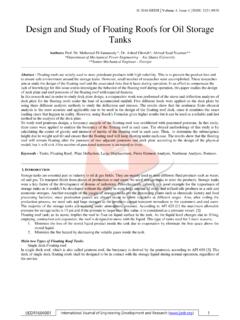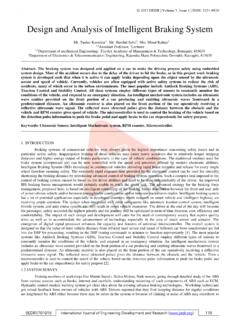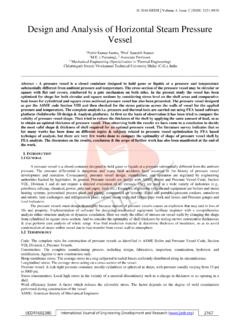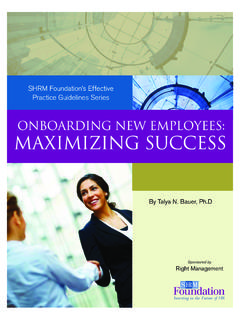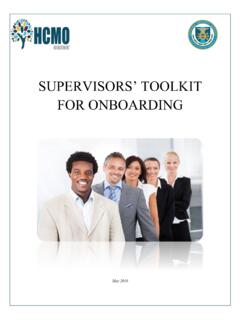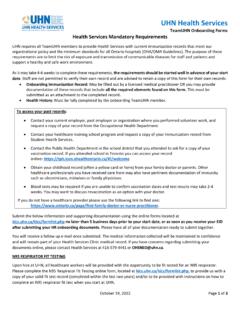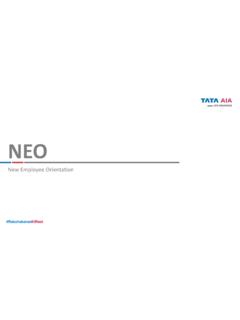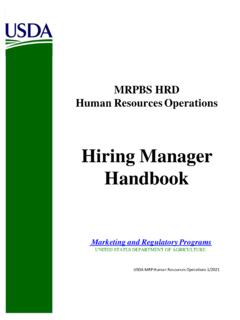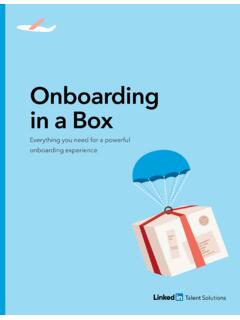Transcription of New employee onboarding process in an organization - IJEDR
1 2017 IJEDR | Volume 5, Issue 1 | ISSN: 2321-9939 IJEDR1701032 International Journal of Engineering Development and Research ( ) 198 New employee onboarding process in an organization Nikhita Kumar, Dr Suruchi Pandey Student, Associate Professor Symbiosis Institute of Management Studies,Symbiosis International University, Pune, India _____ Abstract-The objective of the study is to analyse the present on boarding process in the organization and to find the most critical phase of the on boarding process in the organization . Not at all like customary employee induction or orientation, onboarding is an orderly process that develops well past day or week of employment. The objective of the onboarding procedure is to develop a long haul relationship between the business and the worker while encouraging a sentiment having a place and a confirmation of settling on the right decision. The study has been carried out by a survey through surveymonkey, face to face and telephonic target respondents were 305 out of which 123 responded.
2 So the sample size was data collected from 123 new joinees. The findings of the study were that majority of respondents were not satisfied with the present onboarding process in the organization . The satisfaction percentage of new employees was good only in phase I the pre joining phase. After that the satisfaction levels drop down in subsequent phases. The findings also reveal thatthe most critical phase is phase II first day at work. The satisfaction level of new employees drops down from 70% in phase I to as low as 30% in phase II which is a major fall and a call for concern. If an employee doesn t feel welcomed on Day 1 then the chances of his/her leaving the organization within few months to one year increases. The benefit of this research project is that it will provide the reader with data and statistics of a general viewpoint of new hires in the organization about the onboarding process .
3 It will also provide them with certain suggestions to make the onboarding process effective. Index terms- onboarding , Orientation, Induction, Pre-joining, Team Integration, Feedback _____ I. onboarding - THE NEW BUZZ WORD onboarding is a very trending word in the realm of HR, yet not everybody understands what it is or how to do it .Not at all like customary employee induction or orientation, onboarding is an orderly process that develops well past day or week of employment. The objective of the onboarding procedure is to develop a long haul relationship between the business and the worker while encouraging a sentiment having a place and a confirmation of settling on the right decision. Each business is distinctive, so there isn't one right approach to handle the onboarding procedure of new contracts. Notwithstanding, recall that initial introductions last, so put fourth the additional push to make the most ideal early introductions.
4 According to the Society for Human Resource Management, onboarding is the process by which new hires get acclimatized to all aspects of their jobs rapidly and easily, and learn the KSA and behaviors required to function effectively within an organization . The procedure of on boarding is not obligation of HR alone; every front line manager should also be a part of this process starting from the very first preliminary stage. onboarding needs to be considered as a comprehensive procedure and not some separate stand alone routine action. This may help in improved integration of new employees with the complete system. It has been experienced that employees who have not been properly inducted need a lot more guidance and training and hence proves to be costlier in terms of effort, time and money For the purpose of this research project, the entire onboarding process has been divided into following phases:- (a) Phase I.
5 This is the Pre-joining phase in which the employee is in communication with the recruitment team. In this phase the employee gets the offer letter and all the necessary information about the organization . This phase also involves submission of any documents before the first day at work or giving the new hires list of documents to be submitted on the first day of work. This would prepare the new hire psychologically to adapt to the new environment to with ease. (b) Phase II. This includes the first day at work along with the induction or orientation lasting from one day to a week. In this phase the employee completes the leftover documentation work from phase I and undergoes an induction process wherein the new hire is given complete information about mission, vision of the organization , policies and portals, employee related benefits etc. This phase is basically welcoming the new employee to the organization and making him feel at home.
6 (c) Phase III. This phase includes being an integral part of a team under a supervisor. The employee is briefed about what is expected out of him in alignment to his job description by the supervisor. It includes integration with the team, consistent feedback by supervisor etc. (d) Phase phase includes interactions with HR, feedbacks and training and development. One more concept which needs to be clarified at this point of time is that onboarding and Induction/Orientation are just not the same. Till date there are people in the industry using these two terms as replaceable for each other. On boarding is a bigger umbrella of which induction is a part of. Induction is just a one day or a week process where in the new joinees are informed about the organization s mission, vision, policies, portals, benefits. On the other hand On boarding is a 30-60-90 days process which covers the day an employee makes his first contact with the company the selection phase, Day 1 at work, Training programs, Performance feedback and interactions with team, supervisor and HR to get aligned to the organizational goals and objectives.
7 2017 IJEDR | Volume 5, Issue 1 | ISSN: 2321-9939 IJEDR1701032 International Journal of Engineering Development and Research ( ) 199 Objectives To analyse the present on boarding process in the organization . To find the most critical phase of the on boarding process in the organization . To ascertain the findings through survey and provide recommendations to make on boarding a better process . Limitations The scope of the project was confined to new hires for the last one year only. The project did not take consideration onsite employees. II. REFLECTIONS FROM THE PAST On-boarding is the process of learning, networking, resource allocating, goal setting and strategizing that ends with new hires quickly reaching maximum productivity (Bauer, T. N., & Erdogan B, 2011). This formal process of on-boarding is what assimilates the new employees to rules, procedures, benefits, expectations and the goals of the organization .
8 On-boarding is more than getting the paperwork completed and reading the long and boring employee manual. It is the integration of a new employee to become a highly productive member of the organization . onboarding engages the new employee into the world of the organization . Stimpson (2009) firstly states that the onboarding process is that of acquiring,accommodating, assimilating and accelerating new team members, whether they come from outside or inside the organization . It is used to refer to the administrative work involved with setting an employee up in a new job or role . Poor onboarding processes can have a negative effect on bottom line of the organization . Employees who have had a negative experience going through the onboarding process are very likely to leave the company s employment after a very short period of time. A more structured onboarding process makes for happier, more confident and stronger employees.
9 The employee believes that they fit both the job and the company and feel more engaged with the company strategy and objectives. This feeling of increased engagement by the employee leads to better employee productivity and a reduction in the turnover rate for the company. In short, companies that want to have quicker and enhanced engagement and productivity from their new employees , coupled with the associated cost reductions, should have effective onboarding higher up on their strategic agendas (Day & Fedele, 2012). "Psychological contract" refers to the relationship of the employee and employer and mutual expectations of inputs and outcomes. The onboarding process , if it is done well, should result in a "psychological contract" where the employee knows what is expected of them that will make them successful in their position and how they contribute to the company's success. Since the psychological contract is dynamic and evolving, organizations need to invest effort into understanding the changes and at various times and when needed renegotiate the contract (Lester and Kickul, 2001).
10 Lester and Kickul (2001) shows that a "pro active approach to the psychological contract is likely to reduce an employees intention to leave" since their needs are more likely to be met by the organization . onboarding does not stop at the completion of paperwork and brief organizational history, as does orientation. Instead, onboarding should include coaching, 360 feedback, mentoring, introduction to the organization and team, managers, and subordinates (Gilmore & Turner, 2010). The tasks of orientation should be paired with cultural and organizational training in order for the employees to have a good grasp on where they fit into the organization ("Get onboard with," 2013).It can be very helpful to create a checklist to ensure all topics are covered (Graham & Callahan, 2011). Having the new employee initial the sheet and storing it in his/her file can generate accountability.

